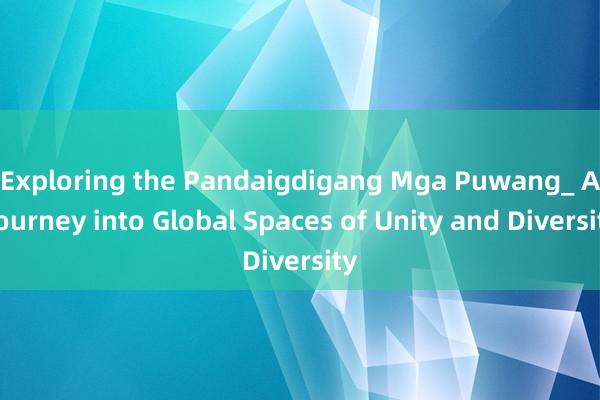Exploring the Pandaigdigang Mga Puwang_ A Journey into Global Spaces of Unity and Diversity


In an era defined by globalization and connectivity, the term "pandaigdigang mga puwang" — a Filipino phrase meaning "global spaces" — resonates powerfully as an expression of the connections we cultivate across borders and cultures. This concept captures the spaces where we come together, whether through physical locations like international communities or virtual networks that enable people to connect and collaborate from anywhere in the world. These global spaces are more than just points on a map; they represent opportunities for mutual understanding, cultural appreciation, and the breaking down of walls that often divide us.
What Are "Pandaigdigang Mga Puwang"?
The concept of pandaigdigang mga puwang goes beyond the literal interpretation of physical places and encompasses a wider array of interconnected spaces where people from different parts of the world interact, share, and build relationships. These global spaces range from multicultural cities and international business hubs to digital platforms, online communities, and even conceptual spaces like global citizenship. Each space becomes a microcosm of humanity, offering a chance to experience the world’s immense diversity and learn from it.
The Power of Physical Global Spaces
Physical global spaces have always been at the forefront of cultural exchange. Cities like New York, Tokyo, Dubai, and London exemplify the essence of pandaigdigang mga puwang as they bring together people from all backgrounds. These cities are melting pots of culture, language, and lifestyle, where new customs, ideas, and technologies cross-pollinate. The diversity in these areas allows residents and visitors alike to experience the richness of global cultures through food, art, festivals, and daily life interactions.
Consider places like Little Italy in New York or Chinatown in San Francisco — vibrant neighborhoods that embody the essence of their respective cultures while existing within another country. These areas serve as living, breathing spaces where global cultures are preserved and celebrated, allowing individuals to step into another part of the world without needing to board a plane. Such neighborhoods are often home to both natives of those countries and immigrants seeking a slice of familiarity. This dual purpose not only preserves heritage but also introduces it to people from different backgrounds, fostering a sense of appreciation and respect.
The international hubs that emerge in these cities also create unique business opportunities and partnerships. Silicon Valley in California, for instance, is not only a tech center but a place where people from around the world collaborate to create innovations that impact global societies. The exchange of ideas in these spaces often leads to groundbreaking advancements in fields such as technology, health, and education, illustrating the powerful synergy that pandaigdigang mga puwang can inspire.
Virtual Global Spaces: Bridging Distances
The rise of the internet has transformed our understanding of global spaces, bringing to life digital realms where boundaries are nonexistent. Virtual spaces offer an alternative to physical global spaces, allowing people from different cultures and backgrounds to interact on a daily basis without ever meeting face-to-face. Online platforms such as Facebook, Instagram, LinkedIn, and Reddit serve as forums where people can share ideas, collaborate on projects, and engage in dialogues that might never have been possible in the past.
Educational platforms are another powerful example. Websites like Coursera, Khan Academy, and Duolingo create a virtual global space where people can learn from instructors and resources worldwide, regardless of geographic limitations. This form of global space democratizes education, making it accessible to anyone with internet access. As more individuals join these platforms,chich69 they contribute to a shared repository of knowledge and cultural insights, go88 tài xỉu further enriching these global learning environments.
Virtual events and webinars have also exploded in popularity, phim rule 34 especially in recent years. Platforms like Zoom, Google Meet, and Microsoft Teams have allowed conferences and gatherings to take place in a way that’s inclusive and widely accessible. From a small-town student in the Philippines attending a coding bootcamp hosted in Silicon Valley to a European entrepreneur pitching their startup to an Asian investor — these virtual platforms create new opportunities for cross-cultural interaction and collaboration.
But virtual global spaces go beyond education and business. They allow people to explore and experience the lives of others, whether through social media, streaming content from different countries, or even participating in online communities focused on topics like wellness, spirituality, or fandoms. For example, streaming platforms have introduced audiences around the world to Korean dramas, Indian Bollywood films, and Japanese anime, bridging cultural gaps and cultivating appreciation for diverse forms of art.
The Role of Language in Global Spaces
Language serves as both a bridge and a barrier in global spaces. English has emerged as a dominant language in many global spaces, particularly in business and academia, yet local languages also play a crucial role in preserving cultural identities. In spaces where many languages converge, the beauty of multilingualism shines through, reflecting the harmonious coexistence of various cultures. Efforts to promote language diversity in global spaces, such as offering multilingual options on websites and translation services in international events, enhance inclusivity, allowing more people to feel seen and heard.
đăng ký đăng nhập slot go88Pandaigdigang mga puwang highlights the importance of languages like Filipino, Spanish, Mandarin, and many others that represent the voices of specific cultures. Even digital spaces like Google Translate have worked toward bridging language gaps, allowing people to communicate with each other in ways they couldn’t before. With each word and phrase that’s understood across cultural boundaries, we are one step closer to a more unified global space.
The Role of Global Spaces in Fostering Cultural Understanding
One of the most powerful aspects of pandaigdigang mga puwang is their ability to promote cultural understanding. As people meet and interact in these spaces, they are often exposed to ideas, beliefs, and lifestyles that may be vastly different from their own. This exposure can be transformative, broadening perspectives and encouraging empathy. In multicultural neighborhoods, for instance, families from different parts of the world live side by side, often sharing their traditions, foods, and ways of life with one another. Children in these communities grow up with a natural appreciation for diversity, learning early on that difference doesn’t have to mean division.
Global spaces also provide avenues for cultural exchange on an individual level. Travelers, students, expatriates, and refugees bring with them not only their personal stories but also unique cultural values and practices. The relationships they form with others become channels for mutual understanding. An American studying in Japan, for example, may develop a deep appreciation for Japanese customs of respect and punctuality, while a Japanese student studying in Europe might embrace the sense of individualism and personal freedom emphasized in Western cultures.
Virtual Global Spaces: A Path to Shared Solutions
The digital world has proven especially valuable for connecting people with shared goals and causes. Climate change, social justice, mental health awareness, and sustainable development are just a few of the global issues that people from all backgrounds are addressing through virtual spaces. Social media campaigns, international petitions, and global forums allow voices from across the globe to be heard, amplifying calls for change and encouraging collective action.
Digital platforms like Twitter and Instagram allow activists from different continents to exchange strategies and resources, while forums on websites like Reddit enable users to discuss challenges they face and offer advice on solutions that have worked in their regions. This interconnectedness cultivates a shared sense of responsibility for the world, underscoring that while our backgrounds may be diverse, we are united in facing global challenges together.
Global Spaces as Foundations for Global Citizenship
One of the ultimate goals of pandaigdigang mga puwang is to cultivate a sense of global citizenship. This term refers to an identity that transcends nationality, encouraging people to see themselves as part of a larger global community. As global citizens, individuals are encouraged to embrace diversity, practice empathy, and contribute to the welfare of the world as a whole. Pandaigdigang mga puwang provide fertile ground for this identity to flourish, as people connect over shared values and universal goals.
For example, study-abroad programs, international work opportunities, and exchange programs offer people a chance to immerse themselves in new cultures and adopt a mindset of openness and adaptability. Similarly, digital spaces that facilitate international collaboration help foster global citizenship. A young professional from Brazil working on a project with colleagues in Germany, India, and Kenya gains a firsthand appreciation for the different ways people approach problem-solving and innovation.
Building Inclusive Pandaigdigang Mga Puwang for the Future
Looking forward, creating more inclusive global spaces requires intentional design and respect for the diversity of experiences and identities. Physical spaces can become more inclusive by incorporating multilingual signs, culturally sensitive design, and inclusive policies. Virtual spaces, meanwhile, benefit from diverse representation in media, localized content, and policies that protect against discrimination and promote safe spaces for all users.
By cultivating pandaigdigang mga puwang that welcome and celebrate diversity, we take steps toward a world that values both our unique identities and our shared human experience. It’s a vision of unity and respect, one where the global space isn’t merely a place but a community, a shared dream, and a hopeful step toward a more connected and compassionate world.
This article, divided into two parts, provides an in-depth exploration of pandaigdigang mga puwang or global spaces, emphasizing their role in fostering cultural exchange, collaboration, and unity across the world.






